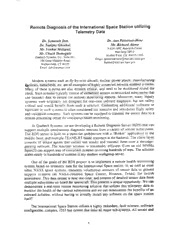
NASA Technical Reports Server (NTRS) 20010073024: Remote Diagnosis of the International Space Station Utilizing Telemetry Data PDF
Preview NASA Technical Reports Server (NTRS) 20010073024: Remote Diagnosis of the International Space Station Utilizing Telemetry Data
Remote Diagnosis of the International Space Station utilizing Telemetry Data Dr. Somnath Deb, Dr. Ann Patterson-Hhte Dr. Sudipto Ghoshal, Mr. Richard Aiena NASA-ARC Research Center Mr. Venkat Malepati, Mail Stop 269-4 Mr. Chuck Domagaht Mofl:ett Field. CA 94035-I000 Qualtech Systems. Inc. Suite 501. Email: apatterson-hine@ mai [.are.nasa.go', 100 Great Meadow Road, [email protected] Veethersfield. CT 06109 Email: deb _'teamqsi.com Modem systems such as fly-by-wire aircraft, nuclear power plants, manufacturing f_ilities, battlefields, etc. are all examples of highly connected ne_'ork enabled systems. ,Many of these systems are also mission critical, and need to be monitored round the clock. Such systems typically consist of embedded sensors in networked subsystems that can transmit data to central (or remote) monitoring stations. Moreover, man', legacy systems were originally not designed tbr real-time onboard diagnosis, but are safety critical and would benefit from such a solution. Embedding additional soft,,vare or hardware in such systems is often considered too intrusive and introduces flight safety and validation concerns. Such systems can be equipped to transmit the sensor data to a remote-processing center tbr continuous health monitoring. At Quahech Systems, we are developing a Remote Diagnosis Server (RDS) that can support multiple simultaneous diagnostic sessions from a variety of zemote subsystems. The RDS server is built on a three-tier architecture with a "'Broker" application in the middle layer, and multiple TEAMS-RT based reasoners at the backend. The client layer consists of sensor agents that collect test results and transmit them over a message- passing network. The resultant solution is remarkably efficient. Even an old 50MHz Sparc20 can support tens of concurrent systems involving hundreds of tests. The solution scales easily to hundreds of systems in any modem workgroup server. One of the goals of the RDS project is to implement a remote health monitoring system based on telemetr2,.' data for the International Space station. It, as well as most other NASA space systems, transmits voluminous amounts of sensor data to ground support systems (at NASA-Johnson Space Center, Houston. Texas) for health assessment. This data stream is near real-time, and consists of detailed sensor data from multiple subsystems on board the spacecraft. This presents a unique opportunity. We can demonstrate a real-time remote monitoring solution that utilizes this telemetry data to monitor the health of the various subsystems and we can demonstrate the benefits of an onboard solution, without having to actually install any software on the space station itselP. The International Space Station utilizes a highly redundant, fault tolerant, software configurable, complex, 1553 bus system that links all major sub-systems. All sensor and In Page1of 1 To: Diane Alexander <[email protected]> Subject: Re: Publication question Hi Diane, It looks like it was the same conference as the other one (they were written by an outside collaborator, so I must not have had the conference info at the time when 1submitted the 1676): S. Deb, C. Domagala, S. Ghoshal, A. Patterson-Hine, and Ri. Alena, " Remote Diagnosis of the International Space Station utilizing Telemetry Data", in Proceedings of the SPIE Aerosense Conference, Orlando, FL, April 16-20, 2001. Thanks, Ann Hi Ann" Here is another title. I am entering into a database all the NASA 1676's for Export Control. Your form for the article "Remote diagnosis of international space station utilizing telemetry data", didn't indicate where this would be published. It was submitted last Sept 2000. Thank you. NASA/Ames Research Center MS 202-3, Diane Alexander Moffett Field, CA 94035-1000 650-604-3140 fax 650-604-4988 Ann Patterson-Hine NASA Ames Research Center MS 269-4 Moffett Field, CA 94035-1000 phone: (650)604-4178 fax: (650)604-4036 Printed for Diane Alexander <[email protected]> 6/7/01
